Ijraset Journal For Research in Applied Science and Engineering Technology
- Home / Ijraset
- On This Page
- Abstract
- Introduction
- Conclusion
- References
- Copyright
Design and Development of a Low-Cost Wastewater Treatment Plant for the NMCE Campus
Authors: Harshad Bhosale, Amrut Patil, Vikramaditya Yadav, Akash Kadam, Vishal Salunkhe
DOI Link: https://doi.org/10.22214/ijraset.2023.54060
Certificate: View Certificate
Abstract
The characteristics and quantity of wastewater are required to get the correct treatment system for wastewater reuse in the NMCE campus. Water is an essential commodity of society. The water availability in NMCE during the summer season is limited, and the wastewater disposal system in NMCE is not methodical. It is directly discharged into open land; therefore, it must design and develop a wastewater treatment plant for the NMCE campus. Wastewater treatment by constructed wetlands is emerging as the low-cost alternative method involving plant species for sewage treatment. The present study will address the design of a wastewater treatment plant for the NMCE campus.
Introduction
I. INTRODUCTION
A. General
Water is an essential and limited resource, but we do not always realize its value. With more people living in cities and using water, there is a strain on our already limited water supplies. That is why we need to find other sources of water that can be used for things that do not need to be drinkable, like collecting rainwater, reusing water, or even using seawater.
B. Relevance
Treating wastewater is essential because it goes through changes that make it unsafe for specific uses, like drinking. We use a lot of water daily, which leads to waste being dumped into our water sources. A big part of the water we use becomes wastewater, so it is crucial to treat it properly. It can spread diseases and make the environment unhealthy if we do not. A study in 2007 found that untreated sewage is a major cause of pollution in India's surface and groundwater. In India, there is a big difference between how much wastewater is created and how much is actually treated.
In some places, wastewater goes into the ground or evaporates, but it can collect and cause problems in urban areas. It creates dirty conditions and lets pollutants seep into our surface and groundwater. We usually treat wastewater with special plants that use steps like separating solids, adding air, and using chemicals like chlorine. But these plants cost a lot to build, need lots of space, and require skilled workers to run and maintain them. They can also be expensive to keep running and might not work well. Because of all this, many governments and organizations do not give enough attention to treating wastewater.
That is why this study focuses on finding a way to treat affordable and effective sewage. We want to develop a technology that solves problems with traditional methods and does not cost too much.
C. Outline of Project Report
The project report is structured into different chapters, each covering specific study aspects. The outline of the project report is as follows:
This dissertation report is divided into 5 chapters which describe the different investigations conducted in this study
- Chapter 1: Introduction This chapter overviews water scarcity and the importance of reusing wastewater. It presents general information about the topic.
- Chapter 2: Literature Review and Objectives In this chapter, previous studies conducted by researchers in the field are reviewed. The research's motivation and the project's objectives are also explained.
- Chapter 3: Methodology and Research Progress This chapter describes the methodology adopted for the study and provides an update on the project's work progress.
- Chapter 4: Theoretical Concepts of Sewage Treatment This chapter focuses on the theoretical concepts of sewage treatment plants. It discusses both conventional wastewater treatment plants and low-cost wastewater treatment plants.
- Chapter 5: Design and Estimation of Low-Cost Wastewater Treatment Systems This chapter presents low-cost wastewater treatment systems' design, drawings, and cost estimation.
- Chapter 6: Discussion This chapter involves a detailed discussion of the findings and results of the study.
- Chapter 7: Conclusion and Future Research In this chapter, the conclusion of the project work is provided, along with suggestions for further research. The report also includes a discussion chapter and a concluding chapter. The Civil Engineering Department is responsible for the construction and implementation of the project.
D. Closure
In this chapter, we provide an introduction to the project. We start by talking about water scarcity, which means that there isn't enough water for everyone. We also explain the importance of reusing wastewater. This means using wastewater again for different purposes instead of just throwing it away. One important use of reused wastewater is for agriculture. We will explain why it is necessary to reuse wastewater in agriculture.
II. LITERATURE SURVEY
A. Solano et al. (2003), "Constructed Wetlands as a Sustainable Solution for Wastewater Treatment in Small Villages."
This research has addressed the concept of Wastewater treatment problems in small villages; the treatment performance of a pilot scale subsurface-flow constructed wetland (SFW) was evaluated for removal efficiency of biochemical oxygen demand (BOD), chemical oxygen demand (COD), total suspended solids (TSS) from raw municipal wastewater. Two different hydraulic application rates (150 and 75mm/day) and two macrophytes were assayed in the wetland. The highest removal percentages were obtained in those beds with the lowest HAR (75mm/day) and the longest retention time (3 days). No significant differences were observed between the two macrophytes. In the seasonal variation, the summer season gives better results than others. Future studies should be done on varying the retention time in the bed to improve the system's efficiency.
B. Vipat et al., (2008) "Efficiency of root zone technology for the treatment of domestic wastewater: a field case study of the pilot project in Bhopal. (MP), India."
Therefore, The paper under reference attempts to evaluate the performance efficiency of field scale horizontal subsurface flow constructed wetland demonstration unit at Ekant Park, Bhopal. Wastewater at Nalla passing through was 70,000 litres/day. The unit contains pre-treatment (settling tank35m3) followed by a root zone bed (700 sq.m) with gravels, reed plants and inlet outland arrangement for subsurface flow. The system performances were recorded monthly for 18 months. The results clearly indicated the removal efficiency of 88.4% for turbidity, 79% for TSS, 70.7% for total solids, 77.8% for COD, and 65.7% for BOD. Results established that the removal efficiency of the system studied ranged from 65% to 90% for various pollutants.
III. OBJECTIVE
The proposed work has the following objectives:
- To collect data and conduct a Detailed study of wastewater treatment.
- To analyze wastewater in the NMCE campus.
- To design a low-cost wastewater treatment plant for the NMCE campus.
- To prepare a lab-scale model of a low-cost wastewater treatment plant.
- To prepare a cost-benefit analysis of a low-cost wastewater treatment plant.
IV. RESEARCH METHODOLOGY
A. Problem Statement
Water is an essential commodity of society. The water availability in Nmce during the summer season is limited, and the wastewater disposal system in Nmce is not methodical. It is directly discharged into open land; therefore, it needs to design and develop a wastewater treatment plant for the NMCE campus.
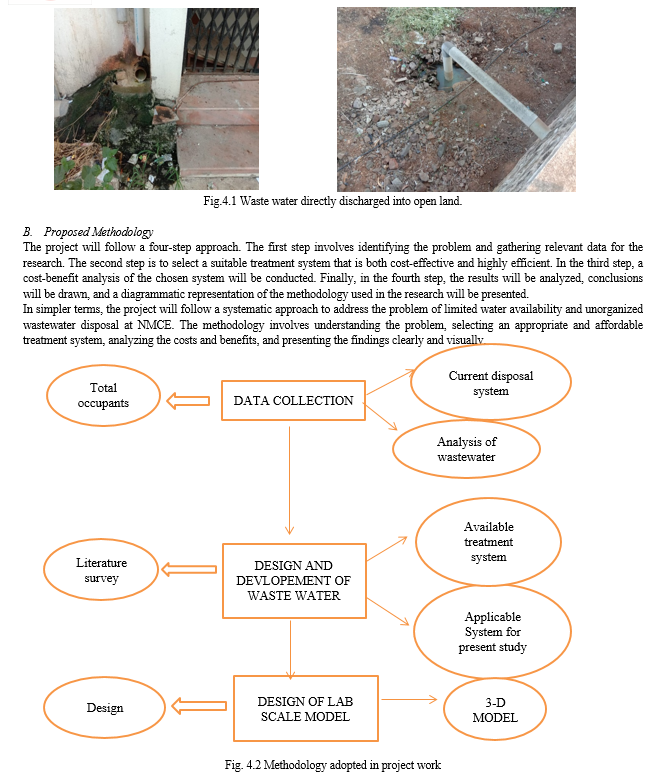
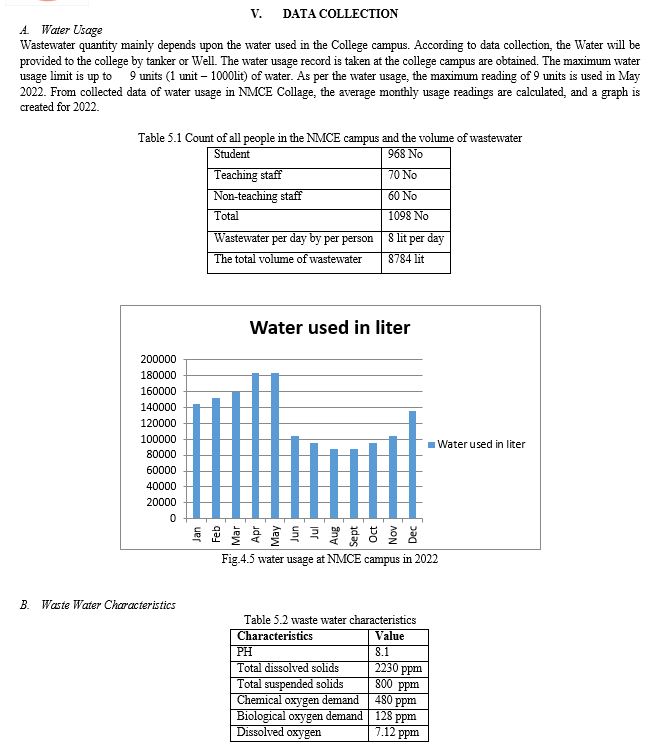
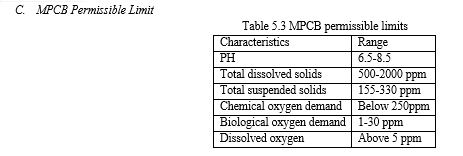
VI. EXPERIMENTAL WORK
A. General
The chapter includes information of the lab scale model, the procedure followed and the observation of the wastewater test.
B. Laboratory Scale Construction Wetland System
A laboratory-scale constructed wetland system is a smaller version of a full-scale system designed for wastewater treatment. In this model, there are two Rectangular tanks with a capacity of 20 litres each, serving as a sedimentation tank and a storage tank. Additionally, there is a rectangular tank with a capacity of 20 litres, measuring 0.3m x 0.2m x 0.2m, which functions as an advance septic tank\The sedimentation tank is positioned at a higher level on a stand. At the same time, the rest of the setup is placed below it. This arrangement allows for maintaining a continuous water flow in the model system. The advanced septic tank consists of three interconnected compartments.
The constructed wetland portion of the system involves filling the tanks with coarse aggregate up to a height of 0.15 meters. On top of the aggregate, sand is spread, and plants are planted in this area. The purpose of this setup is to treat sewage water. When the sewage water enters the system through a drainage pipe, larger particles settle down in the sedimentation tank due to the process of sedimentation. The remaining water then flows into the advanced septic tank, where finer particles also settle down.
The constructed wetland section has a gravel unit where particulate matter further settles down. This helps to minimize the clogging of the subsurface flow constructed wetland system.
Overall, this laboratory-scale constructed wetland system replicates the design and functions of a larger-scale system but on a smaller scale, allowing for experimentation and testing of wastewater treatment processes.
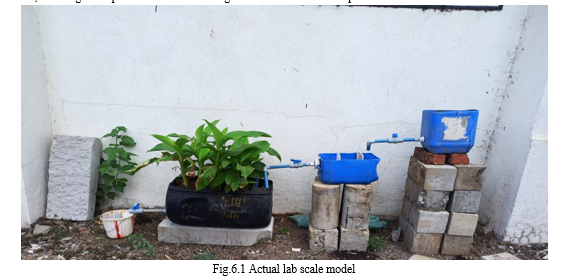
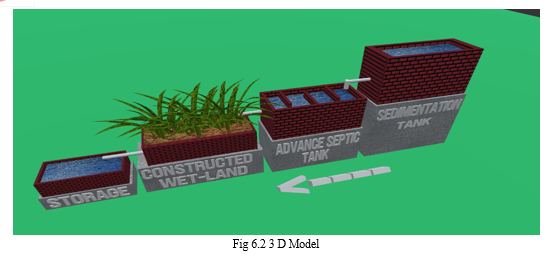
C. Procedure
- Design and Setup
Determine the scale and size of your lab-scale model based on the available resources and the objectives of your study. Consider the dimensions and capacity of each component, such as the sedimentation tank, advanced septic tank, constructed wetland, and storage tank. Select appropriate materials for construction, such as plastic containers or tanks.
2. Sedimentation Tank
Construct a sedimentation tank within your lab-scale model. The tank should have an inlet for wastewater entry and an outlet for effluent discharge.
Ensure proper sizing and design of the sedimentation tank to allow the settling of suspended solids. You may use baffles or other mechanisms to enhance sedimentation efficiency.
Introduce wastewater into the sedimentation tank and allow it to settle sufficiently, enabling solid particles to settle to the bottom.
3. Advanced Septic Tank
Create an advanced septic tank within your lab-scale model. This tank further treats the settled wastewater from the sedimentation tank. Design the tank with compartments to facilitate anaerobic digestion and separation of solids.
Incorporate features such as baffles, outlet filters, and effluent distribution systems to enhance treatment efficiency.
Ensure appropriate retention time for wastewater in the advanced septic tank to promote the further breakdown of organic matter and reduction of pathogens.
4. Constructed Wetland
Develop a constructed wetland within your lab-scale model. This component uses plants and substrates to enhance the treatment of wastewater. Design the wetland cells, considering the flow path and plant arrangement. Use plastic dividers or physical barriers to separate the wetland cells. Select suitable wetland plants known for their ability to absorb nutrients, remove pollutants, and promote microbial degradation. Fill the wetland cells with an appropriate substrate, such as gravel or sand, to support plant growth and provide surface area for microbial activity. Introduce the partially treated wastewater from the advanced septic tank into the constructed wetland and allow it to flow through the cells, promoting biological and physical treatment processes.
5. Storage Tank
Incorporate a storage tank within your lab-scale model to collect the treated effluent from the constructed wetland.
Design the tank with the appropriate capacity to store the treated wastewater.
Ensure proper sealing and protection against contamination to maintain the quality of the treated effluent.
6. Monitoring and Measurements
Install monitoring equipment to measure various parameters within each lab-scale wastewater treatment plant component. This could include flow rates, pH, chemical oxygen demand (COD), biological oxygen demand (BOD), and other relevant water quality parameters. Regularly monitor and record data from the monitoring equipment to assess the performance of each component and the overall treatment plant.
7. Operation and Maintenance
Operate the lab-scale wastewater treatment plant by continuously supplying wastewater to simulate real-world conditions.
Perform regular maintenance tasks such as removing accumulated sludge from sedimentation and septic tanks, maintaining the wetland vegetation, and cleaning the storage tank.
Ensure that each component is functioning correctly and address any operational issues that may arise.
8. Data Collection and Analysis
Collect data from the monitoring equipment at regular intervals.
Analyze the data to evaluate the treatment efficiency of each component and the overall system.
Compare the results with regulatory standards or established benchmarks.
Adjustments and improvements:
Based on the data and analysis, make necessary adjustments to optimize the performance of the lab-scale wastewater treatment plant.
D. Observation
- First Cycle
Table 6.1 Observation of the first cycle
|
Name of test |
Wastewater before treatment |
Wastewater After treatment Sample Day 1 |
Sample Day 2 |
Sample Day 3 |
Sample Day 4 |
|
PH |
8.1 |
7.9 |
7.7 |
7.5 |
7.5 |
|
Total suspended solids (TSS) (PPM) |
800 |
320 |
255 |
247 |
241 |
|
Total dissolved solids (TDS) (PPM) |
2230 |
2157 |
1920 |
1914 |
1804 |
|
Biochemical oxygen demand (BOD) (PPM) |
128 |
112 |
97 |
48 |
29.9 |
|
Chemical oxygen demand (COD) (PPM) |
480 |
322 |
286 |
242 |
238 |
|
Dissolved oxygen (DO) (PPM) |
7.12 |
7.21 |
8.19 |
8.32 |
8.51 |
2. Second Cycle
Table 6.2 Observation of the second cycle
|
Name of test |
Wastewater before treatment |
Wastewater After treatment Sample Day 1 |
Sample Day 2 |
Sample Day 3 |
Sample Day 4 |
|
PH |
8.3 |
8.1 |
7.8 |
7.6 |
7.5 |
|
Total suspended solids (TSS) (PPM) |
790 |
336 |
270 |
256 |
242 |
|
Total dissolved solids (TDS) (PPM) |
2260 |
2175 |
1960 |
1903 |
1871 |
|
Biochemical oxygen demand (BOD) (PPM) |
123 |
103 |
87 |
47 |
29.5 |
|
Chemical oxygen demand (COD) (PPM) |
465 |
332 |
265 |
244 |
240 |
|
Dissolved oxygen (DO) (PPM) |
7.30 |
7.24 |
8.15 |
8.22 |
8.47 |
3. Third Cycle
Table 6.3 Observation of the Third Cycle
|
Name of test |
Wastewater before treatment |
Wastewater After treatment Sample Day 1 |
Sample Day 2 |
Sample Day 3 |
Sample Day 4 |
|
PH |
8.1 |
7.8 |
7.7 |
7.6 |
7.5 |
|
Total suspended solids (TSS) (PPM) |
822 |
345 |
285 |
257 |
251 |
|
Total dissolved solids (TDS) (PPM) |
2248 |
2134 |
1934 |
1924 |
1821 |
|
Biochemical oxygen demand (BOD) (PPM) |
121 |
116 |
96 |
43 |
28.3 |
|
Chemical oxygen demand (COD) (PPM) |
447 |
356 |
278 |
244 |
232 |
|
Dissolved oxygen (DO) (PPM) |
7.38 |
7.40 |
8.12 |
8.36 |
8.41 |
4. Average of all cycle
Table 6.4 Average of all cycle
|
Name of test |
Wastewater before treatment |
Wastewater After treatment Sample Day 1 |
Sample Day 2 |
Sample Day 3 |
Sample Day 4 |
|
PH |
8.1 |
7.9 |
7.7 |
7.5 |
7.5 |
|
Total suspended solids (TSS) (PPM) |
804 |
333.6 |
270 |
253.3 |
244.6 |
|
Total dissolved solids (TDS) (PPM) |
2246 |
2155 |
1938 |
1913 |
1832 |
|
Biochemical oxygen demand (BOD) (PPM) |
124 |
110 |
93.3 |
46 |
29.2 |
|
Chemical oxygen demand (COD) (PPM) |
464 |
336.7 |
276.3 |
243.3 |
236.7 |
|
Dissolved oxygen (DO) (PPM) |
7.3 |
7.3 |
8.2 |
8.3 |
8.5 |
5. Graphical Representation
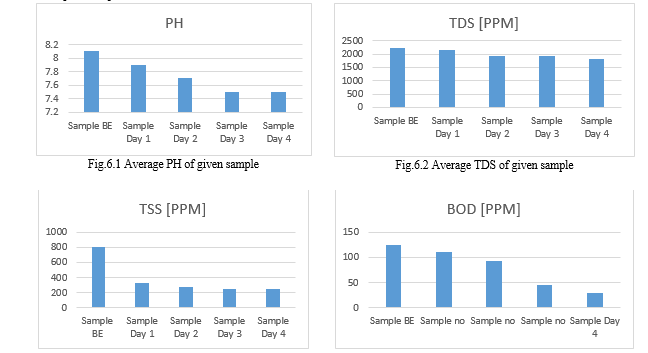
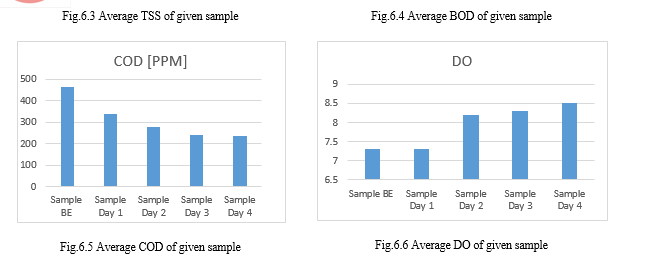
E. Closure
This chapter involves an actual experimental procedure containing construction of lab scale model measuring various water parameters and analysing them.
VII. DESIGN OF LOW-COST WASTEWATER SYSTEM
A. Design Of Low-Cost Waste Treatment Plant
When designing a treatment plant for wastewater, it is important to create a controlled environment that supports biological and physiochemical processes. The goal is to remove contaminants from the wastewater to be reused for farming. In addition to the design and construction of the plant, other factors such as energy consumption, operation and management, and cost-effectiveness should also be considered.
One cost-effective option for wastewater treatment in developing countries is constructing wetlands. These wetlands are designed to mimic natural wetland ecosystems and can effectively treat wastewater. They are relatively inexpensive to construct, manage, and operate compared to other treatment methods.
General standards, limitations, and assumptions from various books and research papers are considered when designing a wastewater treatment system. These guidelines help ensure the treatment plant meets the required quality standards and operates efficiently.
Overall, the aim is to design a treatment plant that efficiently removes contaminants from wastewater, minimizes energy consumption, and is cost-effective to construct and operate. Constructed wetlands are a particularly effective and affordable option, especially in developing countries.
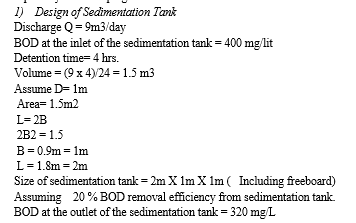
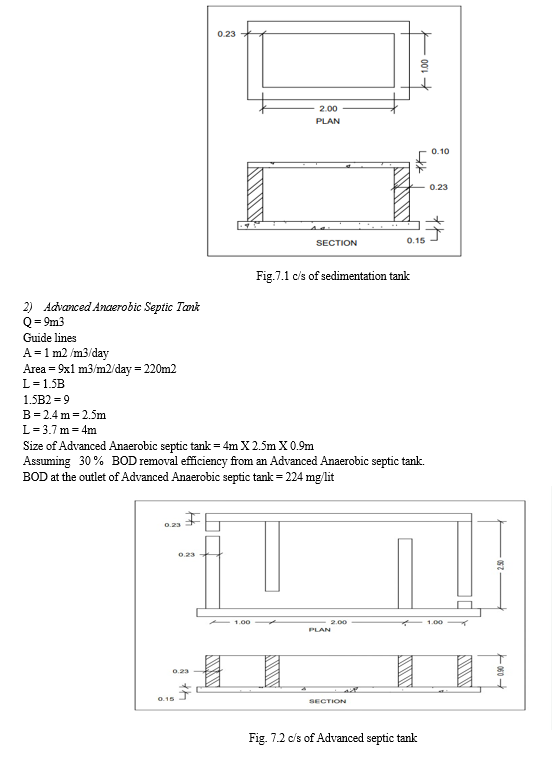
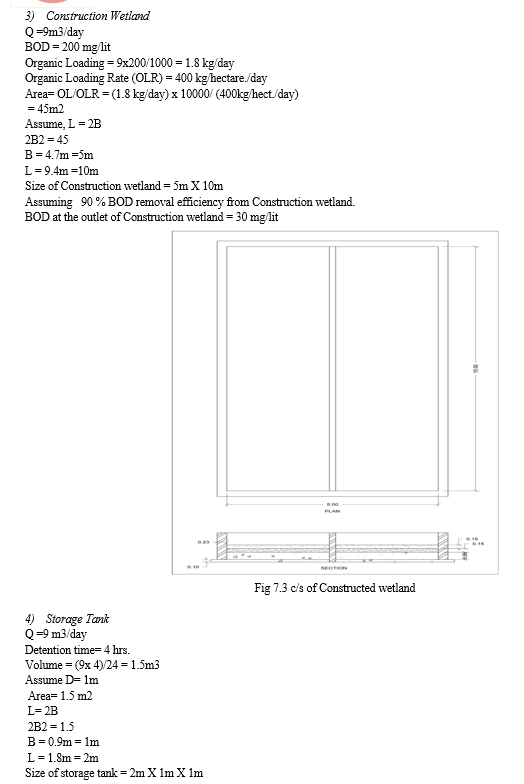
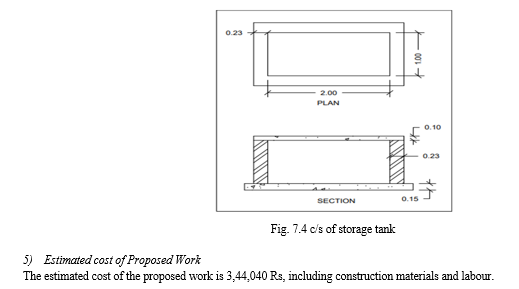
VIII. FUTURE SCOPE
The future scope of constructed wetland systems is promising as they continue to gain recognition and importance in various fields. Here are some potential areas where wetland systems can play a significant role:
- Urban Planning and Sustainable Development: As urban areas continue to expand, the integration of wetland systems into urban planning becomes crucial. Wetlands can help mitigate the impacts of urbanization, such as stormwater runoff, pollution, and habitat loss. Incorporating wetlands into urban design can contribute to more sustainable and resilient cities by improving water management, enhancing biodiversity, and providing recreational spaces.
- Climate Change Adaptation: Wetlands act as natural buffers against climate change impacts, such as flooding, sea-level rise, and extreme weather events. They can absorb and store excess water, reducing the risk of flooding in low-lying areas. Wetlands also sequester carbon and contribute to climate change mitigation efforts. The future may see increased emphasis on using wetland systems as part of climate change adaptation strategies, including coastal protection and floodplain restoration.
- Wastewater Treatment and Resource Recovery: Wetland systems, particularly constructed wetlands, have shown promise in treating various types of wastewater, including municipal and industrial effluents. These systems use natural processes to remove pollutants, nutrients, and contaminants from wastewater, making them suitable for reuse or safe discharge into the environment. The future may bring advancements in the design and optimization of wetland systems for efficient and sustainable wastewater treatment, including recovering valuable resources such as energy and nutrients.
- Ecological Restoration and Conservation: Wetland restoration and conservation efforts are crucial for preserving biodiversity and maintaining ecosystem services. The future may see an increased focus on restoring degraded wetlands, creating new wetland habitats, and connecting fragmented wetland systems. Wetland construction and restoration projects can be implemented on a larger scale, encompassing entire watersheds or river basins, to achieve broader ecological objectives and improve overall ecosystem health.
- Research and Innovation: Wetland systems continue to be a scientific research and innovation subject. Ongoing studies seek to deepen our understanding of wetland ecology, hydrology, and its interactions with surrounding environments. Advances in technology, such as remote sensing, modelling, and data analysis, can further improve the design, monitoring, and management of wetland systems. Additionally, innovative approaches like hybrid wetland systems, bioengineered wetlands, and vertical flow systems may emerge to address specific challenges and optimize wetland performance.Top of Form
Conclusion
The water availability in NMCE during the summer season is limited, and the wastewater disposal system in NMCE is not methodical. It is directly discharged into open land; therefore, it needs to design and develop a wastewater treatment plant for the NMCE campus. Wastewater treatment by constructed wetlands is emerging as the low-cost alternative method, which involves using plant spacies to treat sewage. Constructing a wetland system on a college campus can bring numerous benefits and serve as a valuable addition to the overall infrastructure. Here are some key points to consider: 1) Environmental Benefits: Wetland systems play a crucial role in environmental conservation. They act as natural filters, improving water quality by removing pollutants and excess nutrients such as nitrogen and phosphorus. By integrating a wetland system, the college campus can contribute to local water conservation efforts and help protect nearby ecosystems. 2) Biodiversity Enhancement: Wetlands are known for their rich biodiversity, providing habitats for various plant and animal species. Constructing a wetland system on the college campus can create new habitats and attract various wildlife, including birds, amphibians, and insects. This can be an educational opportunity for students to study and appreciate local ecosystems. 3) Stormwater Management: Wetlands are excellent at managing stormwater runoff. By incorporating a wetland system, the college campus can reduce the burden on existing stormwater infrastructure, mitigate flooding risks, and improve overall water management. This is particularly important in urban areas where impervious surfaces can exacerbate stormwater issues. 4) Educational and Research Opportunities: A wetland system on campus provides an excellent living laboratory for students and researchers. It offers opportunities for hands-on learning, ecological studies, water quality monitoring, and environmental research. Students can actively participate in wetland management, restoration, and conservation projects, gaining practical experience and fostering a deeper understanding of environmental stewardship. 5) Aesthetics and Campus Appeal: Wetland systems can enhance the aesthetic appeal of the campus, providing a tranquil and natural environment for students, staff, and visitors. The presence of water bodies, diverse vegetation, and wildlife can create a more visually pleasing and engaging atmosphere. This can contribute to the overall well-being and satisfaction of the campus community.
References
[1] Y. Patil and G. Munavalli, \"Performance evaluation of an integrated on-site grey water treatment system in a tropical region,\" Ecological engineering, vol. 95, pp. 492–500, 2016. [2] S.Shinde and S.Phad, \"Low cost sewage treatment by root zone technology,\" International Journal of latest trends in Engineering, Science, Humanities and Management, vol. 978, pp. 44–51, 2017. [3] M.Solano, P.Soriano, and M.Ciria, \"Constructed wetlands as a sustainable solution for wastewater treatment in small villages,\" Biosystems Engineering, vol. 87, no. 1, pp. 109–118, 2004. [4] V.Vipat, U.Singh, and S.Billore, \"Efficacy of root zone technology for treatment of domestic wastewater: Field scale study of a pilot project in Bhopal. (mp), India.\" The 12th World Lake Conference, vol. 1, pp. 995–113, 2008. [5] G.Gholikandi, M.Moradhasseli, and R.Riahi, \"Treatment of domestic wastewater in a pilot-scale hsfcw in west Iran,\" Desalination,, vol. 248, no. 1-3, pp. 977–987, 2009. [6] S.Kouki, F.Mihiri, N.Saidi, S.Belaid, and A.Hassen, \"Performances of a constructed wetland treating domestic wastewaters during a macrophytes lifecycle,\" Desalination, vol. 246, no. 1-3, pp. 452–467, 2009. [7] M.Villar, E.Dominguez, F.Tack, J.Ruiz, and R.Morales, \"Vertical subsurface Wetlands for wastewater purification,\" rocedia Engineering, vol. 42, pp. 1960– 1968, 2012. [8] S.Lu, L.Pei, , and X.Bai, \"Study on method of domestic wastewater treatment through new-type multi-layer artificial wetland,\" international journal of hydrogen energy, vol. 40, no. 34, pp. 11207–11214, 2015. [9] G.Munavalli, P.Sonavane, S.Wandare, G.Deshpande, and N.Aswale, \"Effect of media and vegetation in constructed wetland for domestic wastewater treatment,\" Journal of Applied Science and Computations, vol. 5, pp. 8–13, 2018. [10] G.Avila, J.Patinoch, F.zhinion, S.Dpnoso, L.Flores, and A.Avil, \"Performance of phragmites australis and cyperus papyrus in the treatment of municipal wastewater by vertical flow subsurface constructed wetlands,\" International Soil and Water Conservation Research, vol. 7, pp. 286–296, 2019
Copyright
Copyright © 2023 Harshad Bhosale, Amrut Patil, Vikramaditya Yadav, Akash Kadam, Vishal Salunkhe. This is an open access article distributed under the Creative Commons Attribution License, which permits unrestricted use, distribution, and reproduction in any medium, provided the original work is properly cited.

Download Paper
Paper Id : IJRASET54060
Publish Date : 2023-06-14
ISSN : 2321-9653
Publisher Name : IJRASET
DOI Link : Click Here
 Submit Paper Online
Submit Paper Online

